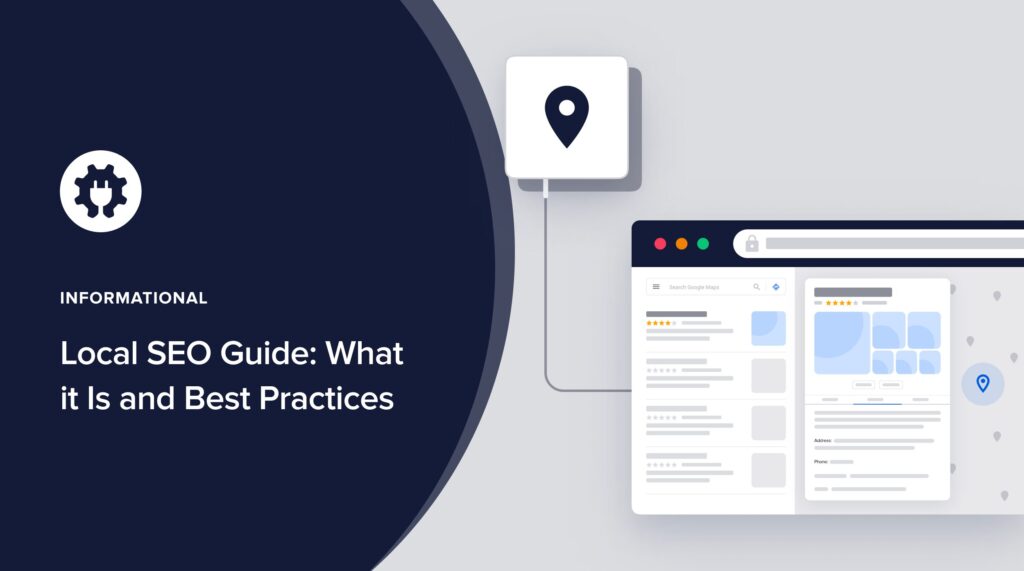Local SEO is one of the most powerful forms of marketing for small businesses.
Done well, local SEO will increase your online visibility, attract nearby prospects, and drive sales.
Some articles on local SEO are unnecessarily complicated. This guide simplifies the topic so you can take immediate action and get results.
Local SEO doesn’t need to be expensive. As you’ll see, even a beginner can learn to do local SEO well for pennies a day.
In This Article
What is Local SEO?
Local SEO is the art and science of optimizing your content so that it ranks well in related local searches.
And what’s a “local search?”
How Does Local Search Work?
No matter where you live, some of your Google searches yield local results. By local results, we mean local places, events, or businesses.
Google takes into account your location and recognizes that some search queries require local options.
Examples of these local queries are:
- Dry cleaner
- 24-hr plumber
- Thai restaurant near me
- Get a taxi
- Grocery delivery
- Wedding videographer
- Order pizza
- Things to do this weekend
- Towing service
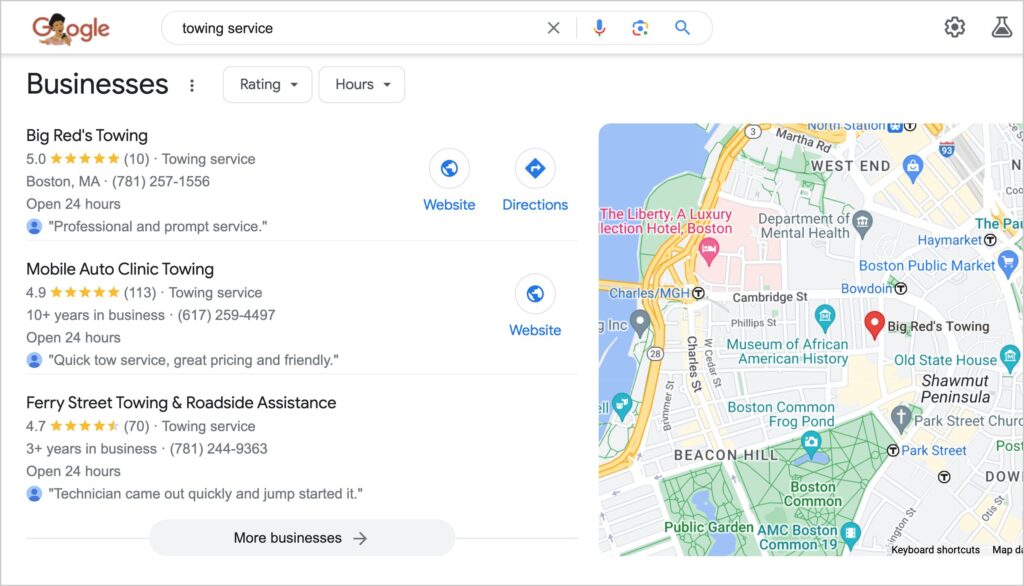
Layout of of Local Search Pages
Many local searches yield pages that look similar. Here’s what you can expect to see.
Ads: If any ads are running on the search term, these ads will appear at the top.
Local Pack: Next, there’s a large display featuring a few businesses next to a map. This is also called the Local Finder.
Organic Results: Below the Local Pack are the organic search results. That’s a fancy marketing term for a list of websites that didn’t pay for ads.
AI: Now that Bard has been incorporated into many search results, you may see an option to “get an AI-powered overview for this search.” (This feature is called Google SGE or Search Generative Experience.)
Of course, local businesses want to rank well in the Local Pack and organic results.
And we’re going to show you how to do that. But first, let’s look at some eye-opening local SEO statistics.
Why is Local SEO Important?
Local SEO is essential because most consumers use online searches and reviews to choose which businesses to visit and buy from.
Take a look at these search statistics.
- 87% of consumers use Google Search to discover and assess local businesses.
- 98% of searchers read online reviews of local businesses
- 76% of locals visit a business within a day of finding it via a search on their mobile device.
- 73% of local shoppers make decisions based on whether the business has any recent reviews.
What’s the Best Local SEO Strategy?
An effective Local SEO strategy addresses key factors that impact ranking.
Those ranking factors can be inferred from Google’s recommendations.
- Google Business Profile: Completeness of your profile matters, as does updating it.
- On-Page SEO: This refers to optimizing your website pages.
- Reviews: Total number of online reviews along with rating average matters.
- Citations: These are mentions or listings of your business on other websites, such as directories.
It’s also essential that your business information (NAP), such as contact information and hours of operation, is accurate across the web.
Getting Started with Local SEO
To get started with local SEO, we recommend you download and install All in One SEO (AISOEO).
This is an established plugin with thousands of 5-star reviews on WordPress.org. Currently, more than 3 million people are using All in One SEO.
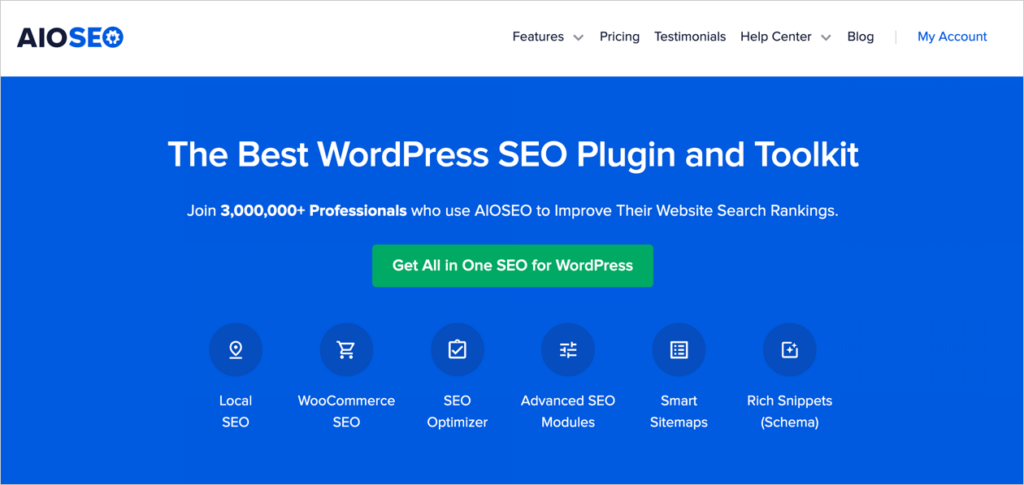
All in One SEO will automate some SEO tasks. And it’ll walk you through the steps required to improve your website’s SEO.
After you download and install the plugin, a setup wizard will walk you through a few steps.
No, you’re ready to dig into local SEO.
Local SEO Action Plan (or “Local SEO Checklist”)
1. Get a Sitemap
Sitemaps are lists, in code, of your website content. While sitemaps aren’t mandatory, they can speed up the process of search engines discovering and indexing your site. And Google recommends using them.
When you install AIOSEO, it automatically creates 2 sitemaps.
These 2 sitemaps are an XML sitemap and an RSS sitemap.
- The XML sitemap lists all content on your site.
- The RSS sitemap only lists recently modified or published content.
Using both types of sitemaps is recommended by Google for “optimal crawling.”
Keep in mind that whenever you publish or modify content, AIOSEO will automatically update your sitemaps. These sitemaps are maintenance-free.
Curious what your sitemaps look like? You can view them by adding, in a browser, /sitemap.xml or /sitemap.rss at the end of your domain name.
RSS and XML refer to the format that sitemaps are created in. RSS stands for Really Simple Syndication. And XML stands for Extensible Markup Language.]
2. Submit Your Sitemaps to Google and Bing
It’s good to inform Google and Bing that your sitemaps have been created.
You’ll do this by submitting your sitemaps to these 2 search engines.
Follow these instructions.
Google is the world’s leading search engine, with a market share of approximately 84%, according to Statista. Bing comes in at 9%.
3. Set up Local SEO Basics
Next, you’ll use AIOSEO to ensure Google Search has your business information and opening hours.
Local SEO Basics
First, be sure you’re logged into WordPress.
Now, in the WordPress admin bar, go to AIOSEO » Local SEO.
A popup window will open, showing 3 tabs: one for Location(s), one for Opening Hours, and one for Maps (optional).
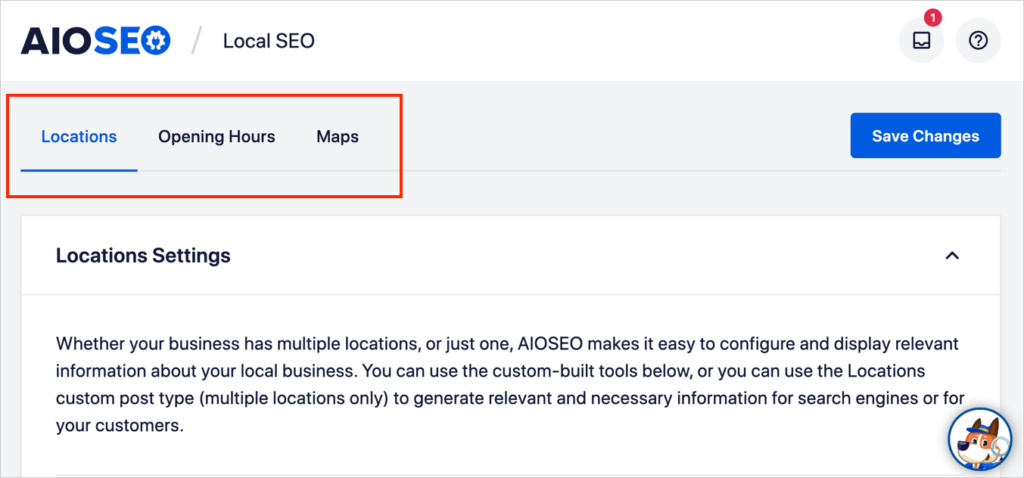
Click on the 1st 2 tabs and fill in your information,
If your business doesn’t have a physical location where you receive customers, skip the address section.
This local SEO process adds code called schema markup to your website.
This helps Google understand your business and match it to relevant search queries.
Optional: Display a Google Map on Your Site
Follow the instructions on the Google Maps tab to display an interactive Google Map featuring your business on your website.
Note: Filling this out isn’t necessary for showing up on Google Maps. As you’ll soon see, creating a free Google Business Profile will ensure your business also shows up on Google Maps.
Next, you’ll review AIOSEO’s recommendations for optimizing your homepage.
4. Optimize Your Homepage
To optimize your homepage, click the AIOSEO icon in the WordPress admin bar and select SEO Analysis from the dropdown menu.
First, you’ll see an SEO score for your homepage.
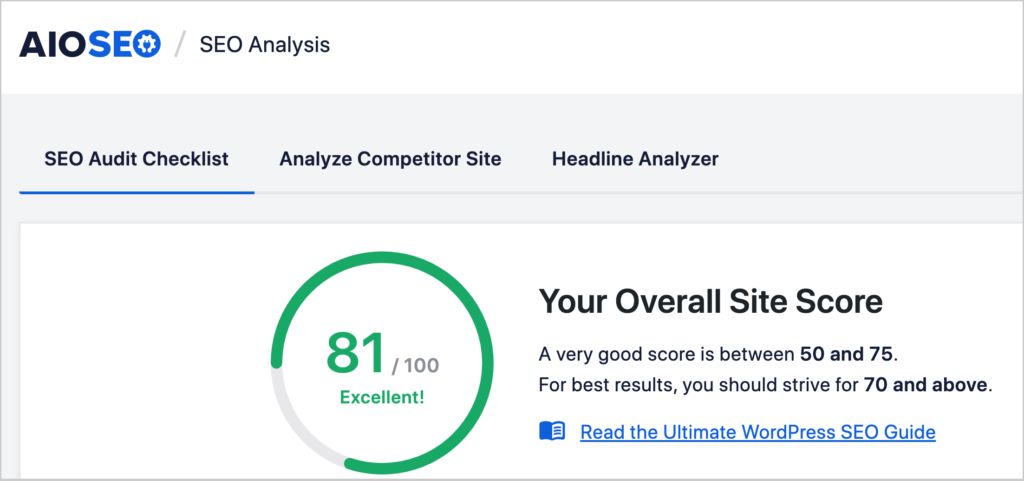
Scroll below your score to find a list of things to take action on.
Click on any item needing improvement, and you’ll find clear instructions for the next steps.
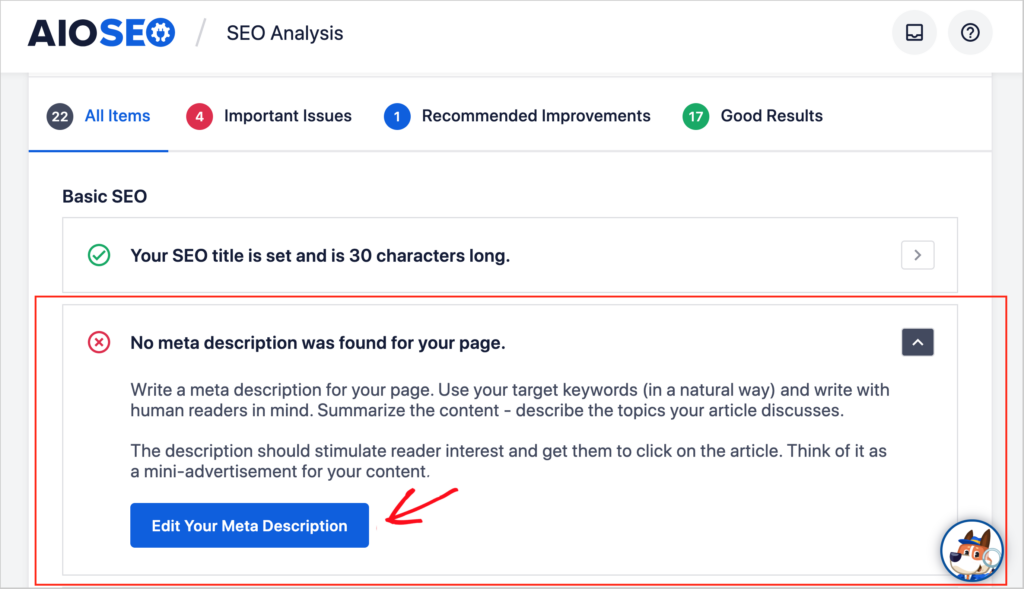
Your homepage score will increase as you act on the plugin’s recommendations.
Optional: You can use SEO Analysis to test your competitors’ homepages. Click on the Analyze Competitor Site tab to do this.
With your homepage optimized for local SEO, it’s time to improve the individual pages of your website.
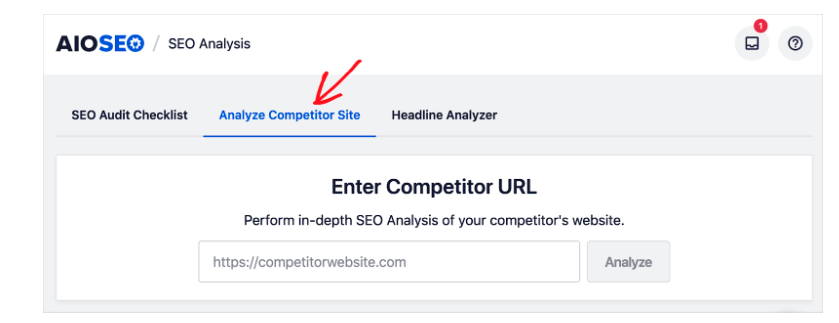
5. Optimize Individual Pages
To get started, navigate to any page you want to optimize.
Then, in the upper right-hand corner, click on the AIOSEO button. That will open the AIOSEO sidebar.
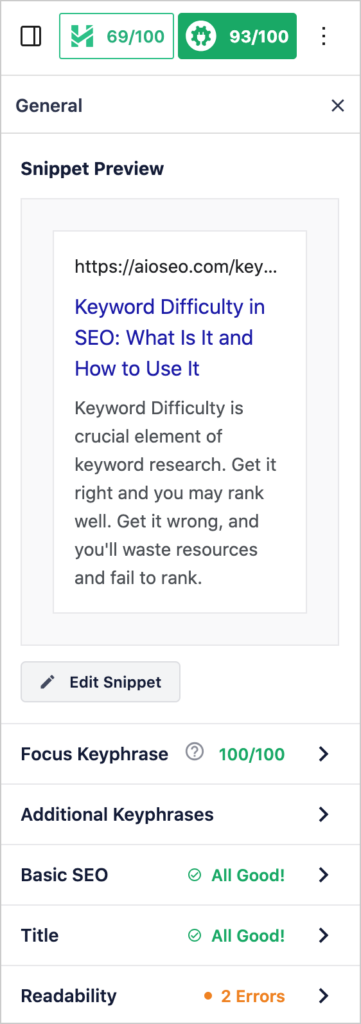
Next, click on General.
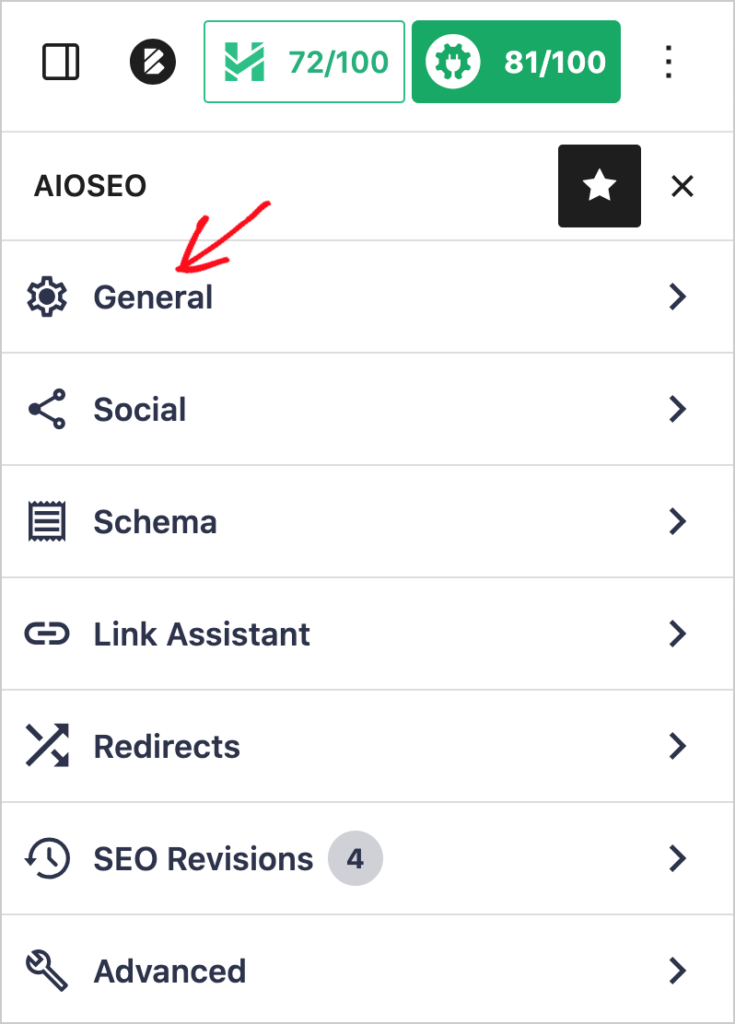
This is where you’ll find the plugin’s recommendations for that page.
The recommendations cover:
- Titles tags and meta descriptions
- Focus keyphrase use
- Readability
Learn more about how to optimize individual pages. [Link to unpublished TruSEO article.]
Another thing: in the AIOSEO sidebar, you’ll also see a tab for Schema. Schema markup is a code that helps Google understand your page content better and rank it for relevant keywords.
All in One SEO includes a Schema Generator, so you don’t need to deal with code.
All in One SEO automatically adds schema for author and article. And you can easily add other types, like these.
- Products
- Product reviews
- Shipping information
- Recipes
- Events
- Books
- Courses (online or offline)
- Datasets
- Software
Adding schema markup to your pages makes them eligible to be displayed as a rich snippet, like the example below.
Rich snippets typically attract more click-throughs from search results.
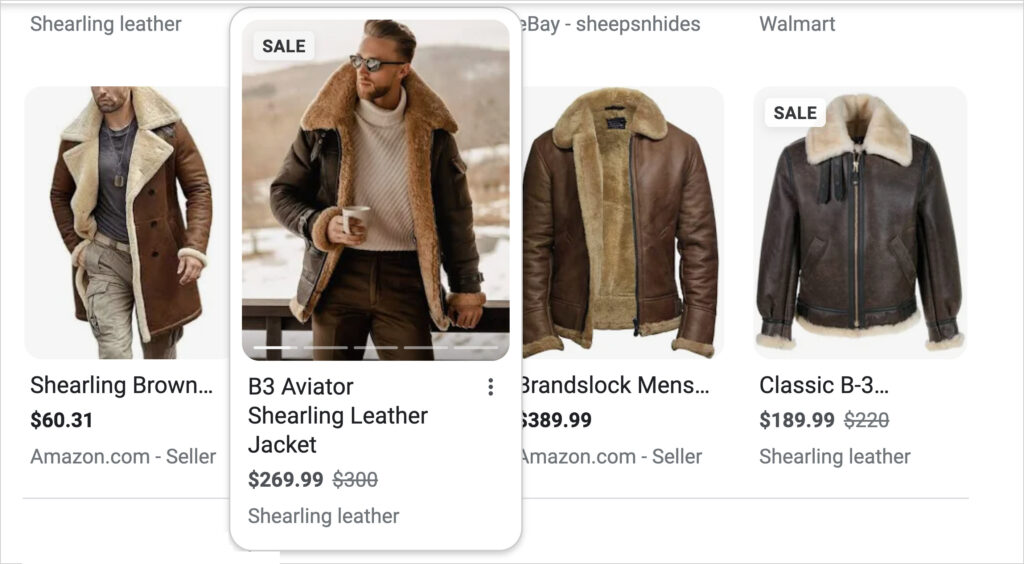
Learn more about rich snippets.
6. Create a Google Business Profile (GBP)
Next, small businesses and local nonprofits should create a Google Business Profile.
It’s easy to create one. All you do is fill in your information. And it costs nothing.
Remember when we discussed factors that impact ranking? This is a big one.
According to a recent survey, marketers consider Google Business Profile the most important factor for ranking well in search engine results pages.
More importantly, Google underscores elements of an effective profile.
- Ensure it’s as complete as possible.
- Keep your business information, including hours of operation, updated.
- Manage and respond to reviews.
After you complete your profile, your organization will appear in Google Maps, and anyone searching for your business by name will see a prominent display in Google search results.
Learn how to optimize your Google Business Profile to boost local SEO.
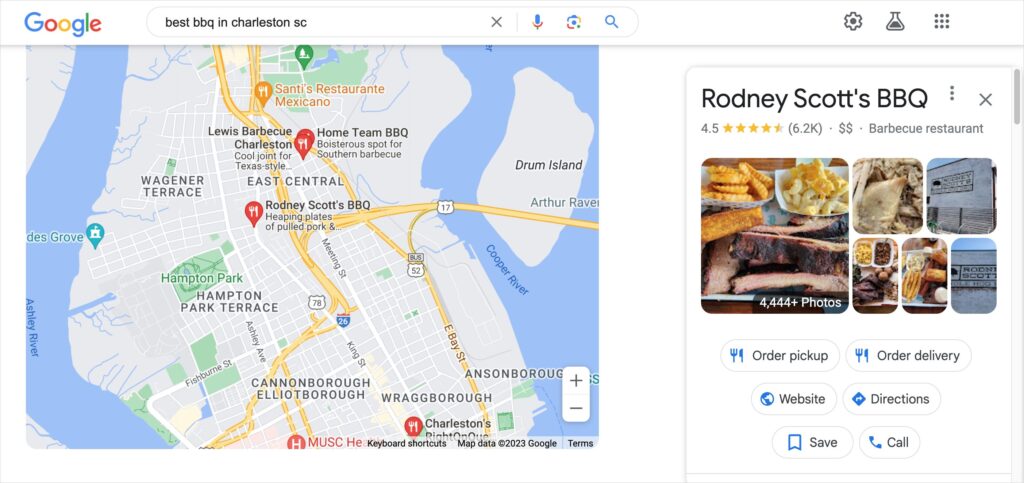
Google Business Profile used to be called Google My Business, or GMB for short.
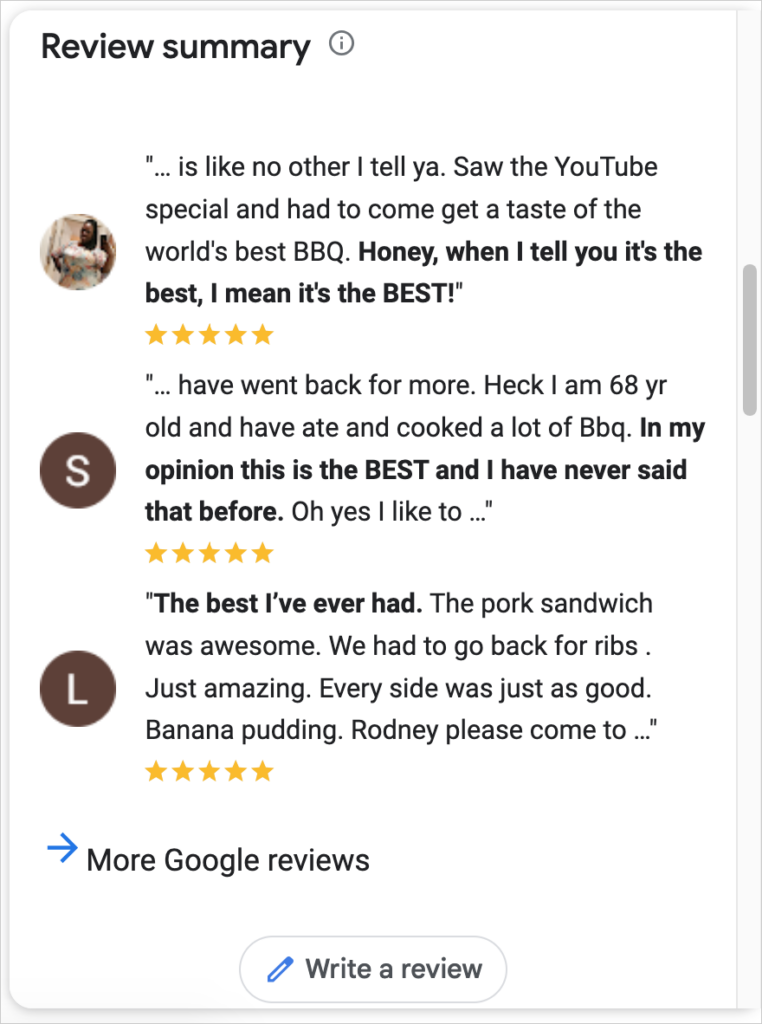
7. Manage Online Reviews
Google Reviews is the most popular and trusted review platform. And Google cites reviews as instrumental in ranking.
Your overall rating average and total number of reviews can influence your rank in the Local Pack.
This is why managing your online reviews is essential for ranking well and gaining new customers.
The good news is it’s easy.
- Ask for reviews
- Reply in a timely way
- Increase your rating average
Many businesses stop after getting their 1st dozen reviews. So, if you keep asking new customers for reviews, you’ll already be 1 step ahead.
Consider these numbers.
- 85% of searchers say a business’s overall average star rating is “important” or “very important.”
- When comparing businesses, 76% of searchers consider which has the higher average star rating.
- And 73% of local consumers look for the presence of recent reviews.
Also, realize these reviews appear in Google Business Profile and Google Maps.
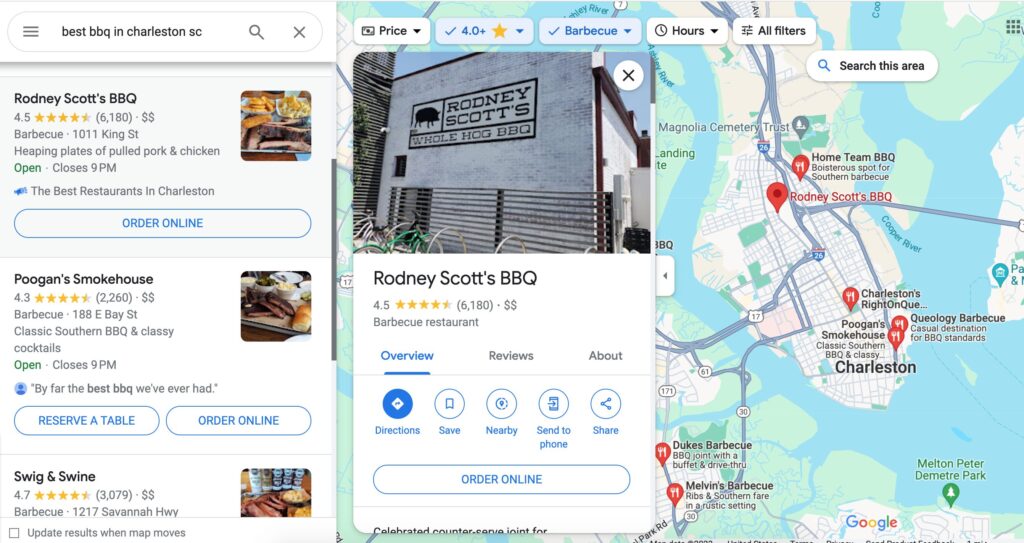
Reviews also appear in Google’s Local Services Ads. And they can show up in AI searches that include the name of your business.
Learn how to manage your Google Reviews for improved SEO.
8. Get Local SEO Citations (Business Listings)
Another ranking factor is citations. These are listings of your business in online directories.
Typically, your business information will be vetted by a data aggregator first. This verification gives Google and directories confidence in the accuracy of your information.
Aggregators often feed your business information to some directories and vehicle GPS navigation systems.
At the same time that you sign up for 1 or more data aggregators, you can request listings in specific online directories.
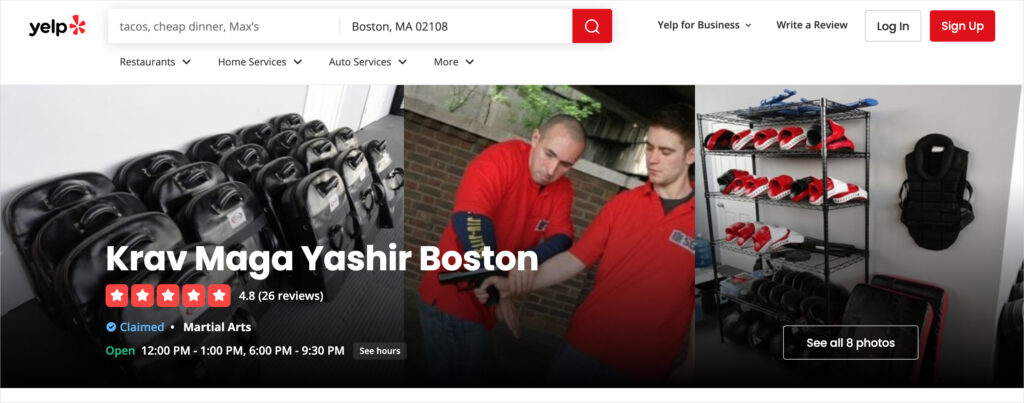
Consumers can be reassured by seeing more than 1 listing of your business online. And as you may have guessed, Google Business Profile counts as a business listing.
Keep NAP Consistent
In SEO, we discuss the importance of keeping your “NAP” consistent. NAP stands for business name, address, and phone number.
But it’s commonly understood to include email information and hours of operation.
The most efficient way to get vetted by a data aggregator, get business listings, and keep your NAP updated across the web is to use a service like BrightLocal.com or WhiteSpark.ca.
Learn how to get local citations.
And learn more about keeping NAP consistent.
Business listings are sometimes called local listings.
Bonus Local SEO Tips
Google Local Services Ads
Consider using Google’s Local Services Ads if you have a service-based business. These are not pay-per-click (PPC) ads; they’re pay-per-lead ads. And you only pay for leads acquired directly via the ad itself.
You can get into Local Services Ads immediately, even if you don’t have a website yet.
Local Landing Pages
And speaking of websites, if you’re looking for a fast way to get a WordPress website up, try SeedProd.
It only takes a few minutes to set up a website. If you want to create different landing pages for multiple locations, you can do that easily by duplicating your site.
SeedProd sites and landing pages are optimized for mobile devices and designed to load fast. Keep in mind that the majority of searches are done via mobile.

Internal Linking
Internal linking is one of the most overlooked SEO tactics. By adding internal links to your most important pages, you’ll communicate their priority to Google, and this can boost rankings.
The Pro version of All in One SEO (AIOSEO) includes a Link Assistant that speeds up internal linking.
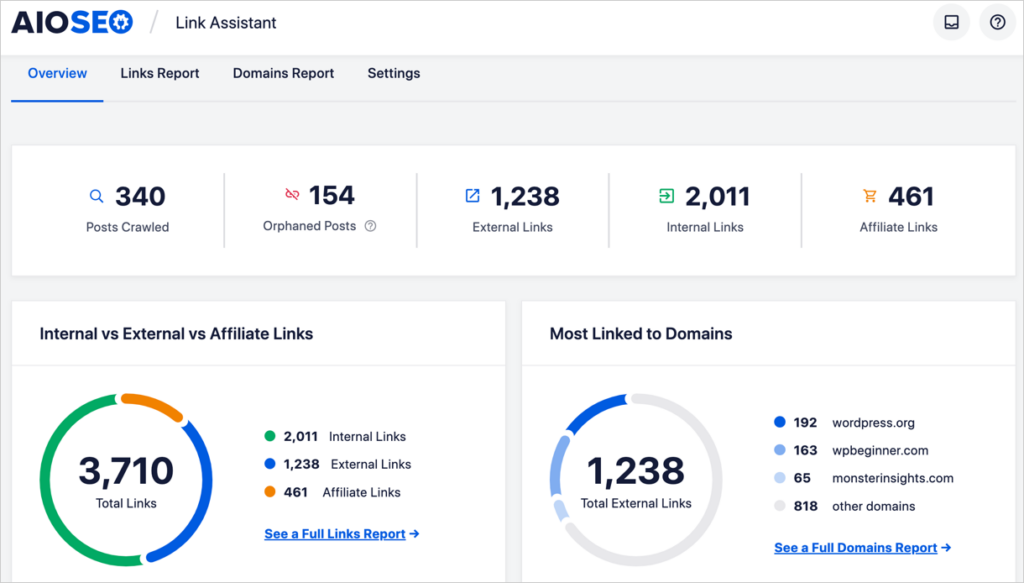
Creating Content for Local SEO
If you regularly create content to attract your prospects (a practice called “content marketing”), you’ll want to take advantage of local angles.
Target Local Topics
For instance:
- A pest control business can create Q&A content about local pests.
- A restaurant can include stories about the farms they get produce from or the history of a local delicacy.
- A plumber in a winter climate can write about frozen pipes.
Local Keyword Research
You can also learn how to do local keyword research. This will reveal the search terms people in your area use when searching for products or services you offer.
Pick some keywords and then create content on those phrases.
Free Local SEO Tools
Looking for free local SEO tools to help with your ongoing SEO journey?
Here are some recommendations.
- SEO Analyzer: Use this free tool from All in One SEO to analyze your website or your competitors.
- AIOSEO Analyzer: This free Chrome extension can speed up SEO checks.
- Google Analytics: Discover traffic and sales trends with this free software.
- Google Search Console: You can grow into this tool. Get data, from beginner-level to advanced.
The Elite version of AIOSEO includes a Google Search Console integration. This means you can see, in WordPress, which keywords you’re ranking for.]
Q&A on Local SEO
How easy (or hard) is it to rank well in local SEO?
It depends. If you’re the only pizzeria in a small town, then your SEO will be easy. But if you’re one of 2,000 pizzerias in New York City, you’ll need to work harder because the competition is fierce.
Be encouraged, though. Many people find it surprising that setting up a free Google Business Profile can significantly impact ranking. Getting more online reviews can, too.
And optimizing your website is made simpler by using a plugin that automates some tasks.
So many small businesses don’t take these simple steps or keep up with reviews. And that provides an opportunity for you.
How much does local SEO cost?
Local SEO pricing depends on whether you’re outsourcing everything or handling some (or all) tasks yourself.
The DIY approach is the most cost-effective: pricing for time-saving software runs around $200 – $300.
Hiring SEO professionals for one-time tasks may run around $800- $1,000. And many marketers charge a monthly retainer fee for ongoing SEO management. This retainer fee depends on the size and complexity of the client’s site and the services requested. It’s not uncommon for the monthly retainer fee to be 4 figures.
For do-it-yourselfers, software tools like All in One SEO (AIOSEO) can automate tasks, like generating and updating sitemaps and providing action steps for improving SEO. Low-cost services like BrightLocal.com charge a one-time fee for business directory listings.
Outsourcing content creation ranges from low-cost options to 4 figures per article. Caveat emptor: you get what you pay for. Low-cost options may contain copy-pasted content from other articles or be wholly generated by AI (artificial intelligence), offering little or no SEO value.
Remember, when you’re hiring someone to write an SEO-optimized article, you’re asking them to create something original, insightful, and better than millions of existing articles on the topic.
How can I save money on local SEO?
Small businesses can save on local SEO by handling routine tasks themselves. WordPress users can use the best-selling All in One SEO (AIOSEO) plugin. And business directory listings can be easily managed with a low-cost service like BrightLocal.com.
If you choose to handle your local SEO, be cautious about signing up for software that charges a monthly fee. While many of these tools are helpful, they often include features you don’t need.
Monthly fees add up quickly, straining small business budgets.
What three things does Google consider in local SEO?
The three things referenced here are factors that Google’s algorithms consider when ranking local businesses. Those factors are:
- Relevance to the search query.
- Distance: which businesses are closest to the searcher.
- Prominence: how well-known a business is and how much information Google has about it. This includes total customer reviews, positive reviews, and business listings.
Is doing local SEO worth it?
Done well, local SEO will boost your online visibility, getting your business in front of qualified prospects. While anyone can learn local SEO, many don’t have the discipline to follow through on simple actions. And that creates an opportunity and potential competitive advantage for you.
Is local SEO free?
Site owners can handle local SEO for free. Using software tools like an SEO plugin and business listings service speeds up the process substantially.
We recommend All in One SEO (AIOSEO) for website SEO and BrightLocal.com for business directory listings. You can do this for under $200.
In addition, creating a Google Business Profile is free.
Can you do local SEO without a website?
You can do some local SEO without a website. You can create a Google Business Profile page to help you reach prospects. Be sure to optimize your profile.
In addition, you don’t need a website to use Google’s Local Services Ads. These pay-per-lead ads appear at the top of search results for select keywords. And prospects can contact you directly through the ad.
However, having an optimized website plays into rankings, too. Consumers may be reassured by seeing a small business that has a standalone website.
What are the top local SEO techniques?
Top local SEO techniques include optimizing your website for SEO, setting up a complete and optimized Google Business Profile page, and getting listed in business directories.
Additionally, online reviews, particularly Google reviews, can impact your overall ranking in the Local Pack and convince prospects to choose your business.
More on Local Search Ranking
Now that you’ve learned how to do local SEO, what can business owners do next to improve local search ranking and get more customers?
- Get clear on the different roles that SEO and social media play in digital marketing.
- Discover the importance of keeping your business information, including your phone number, consistent across the web.
- And get clarity on Google Maps SEO.
Next, improve your marketing strategy with our SEO secrets for growing revenue. Learn how to manage customer reviews for SEO. And explore how to increase leads.
Join us on our YouTube Channel to find simple search engine optimization tutorials. You can also follow us on X (Twitter), LinkedIn, or Facebook to stay in the loop.
Disclosure: Our content is reader-supported. This means if you click on some of our links, then we may earn a commission. We only recommend products that we believe will add value to our readers.
